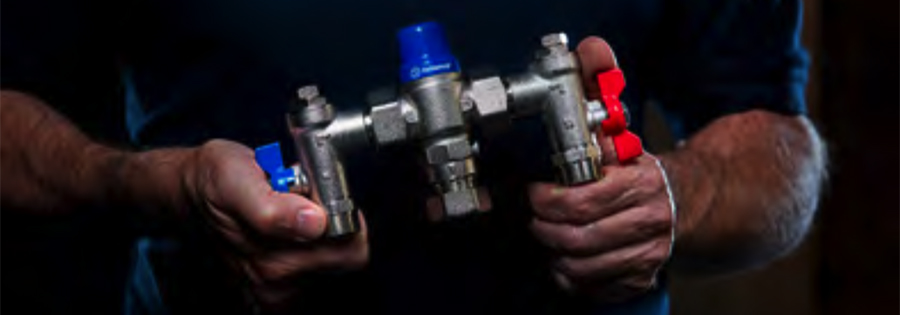Thermostatic mixing valves and water safety
Whether a homeowner or land-lord or a local council, building owners have a duty of care for those living, working, or using their facilities, which is why thermostatic mixing valves (TMV) play a crucial role in all plumbing systems. It is imperative that some form of TMV be specified for every hot water system. The main benefit of a TMV is keeping water at a safe temperature, which therefore prevents scalding and helps stop the build-up of harmful Legionella bacteria. This is achieved by mixing hot and cold-water streams together to ensure a safe temperature at the outlet.
The type of TMV required for an individual application will vary greatly on what kind of building the specification is taking place in, as domestic and commercial buildings have a different requirement to buildings in the healthcare sector.
It is recommended that in domestic and commercial environments, a TMV2 approved valve is specified, and safely installed, tested and maintained to current standards. These valves are designed to reduce the risk of scalding at outlets, while minimising the potential build-up of Legionella bacteria in the pipework that is fed from the outlet side of the valve to the tap. They are typically found under sinks and basins, and never more than 2m away from the outlet they are serving. For buildings occupied by the healthcare sector, such as hospitals, a TMV3 needs to be specified, which functions the same way as a TMV2, but undergoes more rigorous testing, both at the point of installation, as well as every six months after initial sign- off. This is to ensure the safety of the end users, who are likely to be more vulnerable to both scalding and the potential harmful infection from Legionella bacteria.
Where a TMV2 can typically only work with water pressures of 5 bar or below, a TMV3 is safe to work with 10 bars of water pressure.
Water safety in buildings, published by the World Health Organization in 2011, defines thermostatic mixing valves as: ‘Tempering valves that are typically temperature-activated. Used to mix hot and cold water to achieve a predetermined outlet temperature, and that are fitted between the water heater and the point of use to control the distribution temperature. Slightly different temperature ranges are used in some countries.’
Legionnaires' Disease - Operation and Maintenance Log Book (BG 58/2015), written by Reginald Brown and Salim Deramchi, and published by BSRIA in May 2015, defines a thermostatic mixing valve as a: ‘Mixing valve in which the temperature of the water at the outlet is pre-selected and automatically controlled by the valve.’
The above article includes an extract of "Do not get your ABCs confused – all you need to know about TMVs, PRVs and the Tenant Valve" published in the AT journal, issue 144, Winter and written by Richard Bateman, Product Marketing Manager, RWC
--CIAT
[edit] Related articles on Designing Buildings
- A guide to installing thermostatic mixing valves: what, why and how.
- Domestic hot water.
- Mechanical, electrical and plumbing MEP.
- Ofwat.
- Pipework defects, ventilation and airflow rates.
- Pipework.
- Pressure independent control valves.
- Pressure-relief valve.
- Pumps and dewatering equipment.
- Radiator.
- Tap.
- Thermostatic mixing valve.
- Types of valve.
- Types of water.
- Valve.
- Water safety plan WSP
- Water.
Featured articles and news
RTPI leader to become new CIOB Chief Executive Officer
Dr Victoria Hills MRTPI, FICE to take over after Caroline Gumble’s departure.
Social and affordable housing, a long term plan for delivery
The “Delivering a Decade of Renewal for Social and Affordable Housing” strategy sets out future path.
A change to adoptive architecture
Effects of global weather warming on architectural detailing, material choice and human interaction.
The proposed publicly owned and backed subsidiary of Homes England, to facilitate new homes.
How big is the problem and what can we do to mitigate the effects?
Overheating guidance and tools for building designers
A number of cool guides to help with the heat.
The UK's Modern Industrial Strategy: A 10 year plan
Previous consultation criticism, current key elements and general support with some persisting reservations.
Building Safety Regulator reforms
New roles, new staff and a new fast track service pave the way for a single construction regulator.
Architectural Technologist CPDs and Communications
CIAT CPD… and how you can do it!
Cooling centres and cool spaces
Managing extreme heat in cities by directing the public to places for heat stress relief and water sources.
Winter gardens: A brief history and warm variations
Extending the season with glass in different forms and terms.
Restoring Great Yarmouth's Winter Gardens
Transforming one of the least sustainable constructions imaginable.
Construction Skills Mission Board launch sector drive
Newly formed government and industry collaboration set strategy for recruiting an additional 100,000 construction workers a year.
New Architects Code comes into effect in September 2025
ARB Architects Code of Conduct and Practice available with ongoing consultation regarding guidance.
Welsh Skills Body (Medr) launches ambitious plan
The new skills body brings together funding and regulation of tertiary education and research for the devolved nation.
Paul Gandy FCIOB announced as next CIOB President
Former Tilbury Douglas CEO takes helm.
UK Infrastructure: A 10 Year Strategy. In brief with reactions
With the National Infrastructure and Service Transformation Authority (NISTA).
























